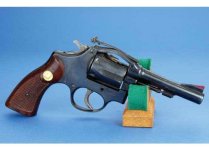everettstiles
Member
- Joined
- May 16, 2011
- Messages
- 10
- Reaction score
- 2
....why a 9mm chamber can stand more pressure and get more speed than a .38. given equal bullet weights.
"But standard pressure 9×19 Parabellum have a SAAMI rating of 35,000 psi (more than double the pressure standard .38 Special loads can handle), and higher pressure +P loads can go as high up as 38,500 psi (also more than double the pressure the .38 Special +P can handle)."
'however, 38SPL has a case capacity of 23.4 grams H2O while 9mm has a case capacity of 13.3 grams H2O. that’s about half as much."
With larger case (and powder) capacity, why doesn't the .38 outperform. What about in an indestructible .357 Blackhawk?
The case capacity is 1.759 more for the .38.
"But standard pressure 9×19 Parabellum have a SAAMI rating of 35,000 psi (more than double the pressure standard .38 Special loads can handle), and higher pressure +P loads can go as high up as 38,500 psi (also more than double the pressure the .38 Special +P can handle)."
'however, 38SPL has a case capacity of 23.4 grams H2O while 9mm has a case capacity of 13.3 grams H2O. that’s about half as much."
With larger case (and powder) capacity, why doesn't the .38 outperform. What about in an indestructible .357 Blackhawk?
The case capacity is 1.759 more for the .38.

